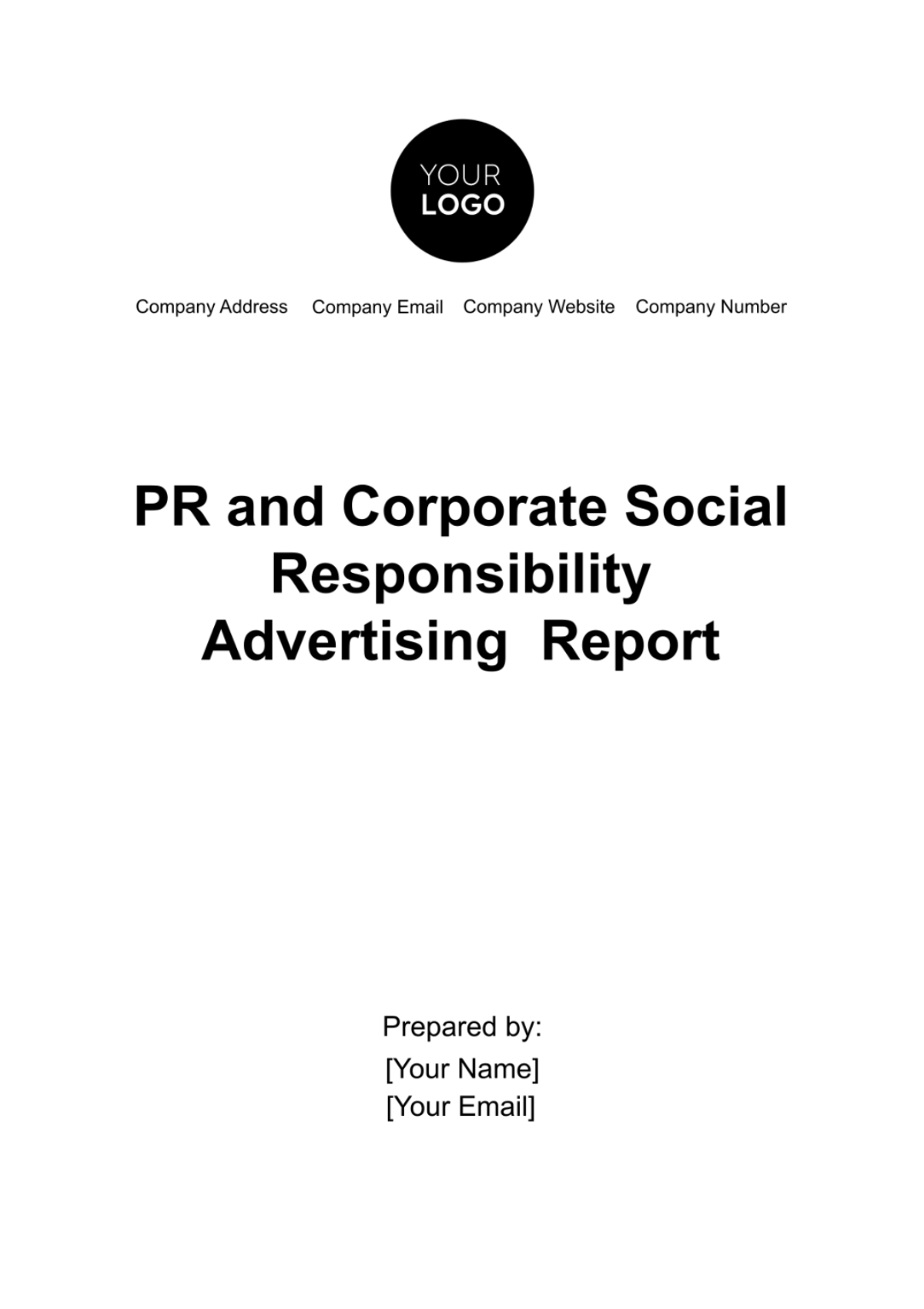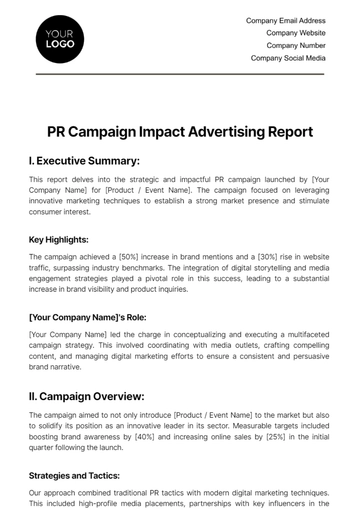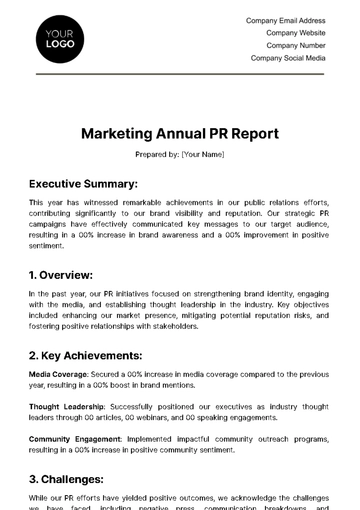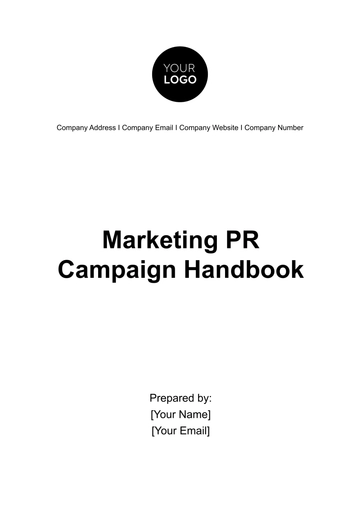Free PR and Corporate Social Responsibility Advertising Report

1. Executive Summary
[Your Company Name] operates at the intersection of fashion, ethics, and community engagement. In our pursuit of excellence, we prioritize not only delivering superior products but also embodying values that resonate with our customers. This Executive Summary encapsulates the key findings and recommendations from our comprehensive PR and Corporate Social Responsibility (CSR) Advertising Report.
Our PR strategies have centered on fostering transparent communication, building brand authenticity, and engaging with diverse stakeholders. Through a combination of strategic press releases, engaging events, influencer partnerships, and active media engagement, we've aimed to cultivate a narrative that aligns with our ethos.
On the CSR front, our initiatives have been multifaceted, focusing on sustainable sourcing practices, ethical manufacturing, charitable contributions, and meaningful community involvement. These efforts underscore our commitment to social and environmental responsibility while striving for operational excellence.
In conclusion, this PR and CSR Advertising Report encapsulates our unwavering dedication to maintaining the highest standards of ethical conduct, sustainability, and community impact. Through this strategic roadmap, we aspire to fortify our brand's connection with our audience while leaving a positive footprint on society.
2. Overview of PR and CSR Initiatives
In this section, we delve into the intricacies of our PR efforts, emphasizing communication strategies such as press releases, events, and media engagement. Additionally, we showcase our CSR initiatives, highlighting our sustainable sourcing, ethical manufacturing practices, charitable contributions, and active involvement within local communities.
2.1 Overview of PR Initiatives:
Press Releases: Throughout the reporting period, we strategically deployed press releases to announce significant milestones. Notably, the launch of our sustainability initiative, including detailed insights into our commitment to reducing environmental impact through innovative manufacturing processes, garnered significant media attention.
Events and Collaborations: Our engagement extended beyond traditional PR channels through experiential events. The collaboration with renowned environmental activists and fashion influencers for a panel discussion on sustainable fashion was a highlight, amplifying our message to a wider audience.
Media Engagements: Our proactive approach to media interactions resulted in several features highlighting our CSR efforts. Interviews with key leadership members showcased our dedication to ethical business practices and our vision for a more sustainable future.
2.2 Overview of CSR Initiatives:
Sourcing Practices: Our commitment to sustainable sourcing was reflected in our partnerships with eco-conscious suppliers. These collaborations led to a substantial increase in the use of recycled materials in our clothing lines, reducing our environmental footprint.
Ethical Manufacturing: Implementing stringent ethical standards across our manufacturing processes remained a focal point. Our adherence to fair labor practices and the adoption of eco-friendly production methods were communicated transparently to our consumers.
Charitable Endeavors: Our ongoing partnerships with local NGOs saw a significant boost during this period. Our contributions to causes aligned with our values, such as supporting underprivileged communities and promoting education, exemplified our commitment to social responsibility.
Community Involvement: Beyond financial contributions, our team actively engaged in volunteering initiatives. Employee-le d community projects, such as organizing clothing drives for those in need, strengthened our ties with local communities.
3. Analysis of Advertising Campaigns
Our brand's narrative lies a series of deliberate and impactful advertising campaigns. This section serves as a magnifying glass, dissecting these campaigns to uncover their effectiveness in communicating our Corporate Social Responsibility (CSR) initiatives.
3.1. Messaging Evaluation:
Content Review: Conduct a comprehensive review of the messaging within each campaign, assessing how effectively it conveyed our CSR initiatives. Evaluate the clarity, authenticity, and alignment with our brand values.
Key Themes Identification: Identify recurring themes or messages that resonated strongly with our audience and contributed to the narrative of sustainability and social responsibility.
Messaging Consistency: Assess the consistency of messaging across different platforms and channels to ensure a cohesive brand story.
3.2. Visual Elements Assessment:
Visual Appeal: Evaluate the visual elements used in campaigns, including images, videos, graphics, and design aesthetics. Determine their alignment with our CSR values and their ability to capture attention.
Representation of CSR Initiatives: Analyze how visual elements portrayed our CSR initiatives, such as showcasing sustainable practices, ethical manufacturing, or community engagement efforts.
Visual Cohesion: Ensure consistency in visual branding across various campaign materials to maintain a strong and recognizable brand identity.
3.3. Channel Strategies Examination:
Channel Effectiveness: Assess the performance of different advertising channels used, including social media platforms, print media, online ads, and influencer collaborations. Identify the channels that yielded the highest engagement and impact.
Audience Reach: Evaluate the extent to which each channel reached our target audience, considering demographics, geographic location, and behavior patterns.
Channel Optimization: Identify opportunities to optimize channel strategies based on the analysis, reallocating resources to the most effective platforms or exploring new channels for greater impact.
4. Comparative Analysis
In the dynamic landscape of our industry, understanding where we stand in relation to our peers is pivotal. This section presents a comparative lens through which we evaluate our Public Relations (PR) and Corporate Social Responsibility (CSR) efforts against industry benchmarks and competitors.
4.1 Comparative Analysis:
PR Strategies Comparison: Analyze industry benchmarks for PR strategies, considering the use of press releases, events, media engagement, and influencer collaborations. Compare our approaches with industry leaders to identify areas for improvement or innovation.
CSR Initiatives Comparison: Evaluate industry standards for CSR initiatives, focusing on sustainable sourcing, ethical manufacturing, charitable contributions, and community involvement. Compare the scope and impact of our initiatives with those of key competitors.
4.2. Competitor Analysis:
PR Practices of Competitors: Study competitors' PR practices, analyzing their communication strategies, media interactions, and events. Assess how effectively they convey CSR-related messages to their audience.
CSR Initiatives of Competitors: Investigate competitors' CSR initiatives, examining their commitments to sustainability, ethical manufacturing, and community engagement. Identify unique initiatives or successful strategies adopted by competitors.
4.3. Key Performance Indicators (KPIs) Comparison:
Quantitative Metrics Evaluation: Compare quantitative KPIs related to PR and CSR impact with industry benchmarks. This includes metrics like brand sentiment analysis, customer engagement rates, and market share growth attributed to CSR activities.
Qualitative Analysis: Assess qualitative aspects such as consumer perception, brand reputation, and stakeholder trust by reviewing industry reports, customer feedback, and surveys.
5. Recommendations and Strategies
As we navigate the ever-evolving landscape of fashion and ethical responsibility, this section serves as a compass guiding our next steps. Here, we outline actionable recommendations and strategic pathways forged from insights gleaned through our analysis of Public Relations (PR) and Corporate Social Responsibility (CSR) efforts.
5.1. Refinement of PR Strategies:
Enhanced Communication Tactics: Implement storytelling techniques to vividly communicate CSR initiatives across all PR channels, fostering emotional connections with our audience.
Transparency and Authenticity: Prioritize transparency in communications, showcasing our journey towards sustainability and ethical practices. Ensure that authenticity remains at the core of all PR interactions.
Exploration of New Channels: Explore emerging platforms or unconventional PR channels that resonate with our target demographic, fostering broader engagement with our CSR narratives.
5.2. Enhancement of CSR Initiatives:
Expansion of Sustainable Sourcing: Increase efforts in sourcing environmentally friendly materials and explore partnerships with suppliers committed to sustainable practices.
Innovative Ethical Manufacturing: Advance our ethical manufacturing practices by adopting cutting-edge technologies or processes that minimize environmental impact while ensuring fair labor practices.
Amplified Community Engagement: Strengthen community involvement by initiating more impactful programs or collaborations that address local needs and reflect our commitment to social responsibility.
5.3. Collaborative Partnerships:
Strategic Collaborations: Seek partnerships with like-minded organizations, NGOs, or influencers aligned with our CSR values to amplify our impact and reach.
Stakeholder Engagement: Engage stakeholders, including employees, customers, and investors, in our CSR journey by fostering dialogue and involvement in meaningful initiatives.
6. Future Roadmap
In the realm of progress and purpose, the Future Roadmap serves as our compass, charting the trajectory for our journey ahead. This section delineates a strategic blueprint, detailing the steps necessary to amplify our Public Relations (PR) efficacy and further elevate our Corporate Social Responsibility (CSR) commitments.
6.1. Strategic Implementation Plan:
6.1.1 Timeline for Implementation:
Q1: Commence the implementation of refined PR strategies by launching a new storytelling campaign highlighting CSR initiatives.
Q2: Initiate partnerships with eco-friendly suppliers to increase the use of sustainable materials by 20% in our upcoming collections.
Q3: Roll out employee engagement programs focused on volunteering and community involvement, aiming for a 30% increase in volunteer participation by year-end.
6.2. Measurement and Monitoring Mechanisms:
6.2.1 Key Performance Indicators (KPIs):
Track website traffic, engagement rates, and conversion rates attributed to the new PR campaigns.
Monitor the percentage increase in sustainable material usage and community engagement metrics.
Conduct bi-monthly reviews to analyze campaign performance against set KPIs.
Quarterly assessments of sustainability metrics to ensure progress aligns with targets.
6.3. Strategic Responsibilities and Accountability:
6.3.1 Role Assignments:
Assign the PR manager to oversee campaign execution and collaborate with the CSR team for content alignment.
Designate sustainability officers to liaise with suppliers and monitor the use of sustainable materials.
6.3.2 Accountability Structures:
Monthly progress reports from each department head to the Chief Sustainability Officer and Chief PR Officer.
6.4. Iterative Adaptation and Flexibility:
6.4.1 Adaptation to Market Dynamics:
Quarterly trend analysis to adapt messaging and campaign content accordingly.
Flexibility in sourcing to explore new sustainable materials based on market availability and advancements.
6.4.2 Feedback Loops:
Implement quarterly employee feedback sessions to gather insights for refining community engagement programs.
Customer surveys post-campaign to assess brand perception and CSR resonance.
6.5. Reporting and Communication Framework:
6.5.1 Reporting Structure:
Monthly reports to the board highlighting progress against KPIs.
Bi-annual stakeholder reports showcasing CSR impact and PR achievements.
6.5.2 Internal and External Communication:
Internal newsletters and meetings to update employees on progress and encourage engagement.
External press releases and social media updates to inform customers and stakeholders about milestones achieved.
7. Conclusion
In this comprehensive report, we've embarked on an exploration of our journey in intertwining Public Relations (PR) strategies and Corporate Social Responsibility (CSR) initiatives within the fabric of our brand. Through meticulous analysis, we've uncovered insights that illuminate our path toward a future where fashion intertwines seamlessly with ethical responsibility.
The strategies outlined in this report serve as the cornerstone of our commitment to transparency, sustainability, and community impact. By refining our PR approaches to authentically communicate our CSR initiatives and amplifying our ethical commitments, we propel ourselves towards a future where our brand narrative becomes synonymous with positive change.
As we navigate this evolving landscape, the resonance of our brand is poised not just to captivate but to inspire meaningful action. Through collective effort, dedication, and unwavering commitment, we are poised to carve a lasting legacy—a legacy that transcends fashion and embodies a profound responsibility toward a better world.
Prepared By: [Your Name]
Date: [Date]
For further details, please contact [Your Personal Email] or visit [Your Company Website].
- 100% Customizable, free editor
- Access 1 Million+ Templates, photo’s & graphics
- Download or share as a template
- Click and replace photos, graphics, text, backgrounds
- Resize, crop, AI write & more
- Access advanced editor
Introducing Template.net's PR and Corporate Social Responsibility Advertising Report Template. This editable and customizable tool, powered by our Ai Editor Tool, simplifies reporting on PR and CSR initiatives. Effectively analyze and communicate the impact of your campaigns. Elevate your reporting with Template.net's innovative solutions.





























